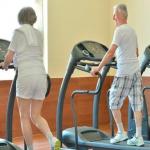How to Diagnose Joint Pain in Older People
Many of us have heard that as we begin to age, our bodies can oftentimes show signs of wear and tear. So when the seniors in our lives start to speak of feeling pain, stiffness, swelling or achiness, we may simply charge it to them getting older when the reality is that it may be an indication that they are having some underlying health issues.
In order to make sure that the elderly in your life get the relief from any joint pain that they may have, we wanted to provide you with some of the common health issues that are directly related to joint pain so that you can know when to take them to the doctor for a proper diagnosis.
Arthritis. One of the most common causes of joint pain, especially in older people, is arthritis. As a matter of fact, it’s so common in America that over 40 million individuals are currently living with it. Aside from the tenderness or achiness in their joints, if they also have a fever, swollen glands, complain of extreme fatigue or you see signs of dramatic weight loss, these are all warning flags that they may have an acute or even severe form of arthritis. Blood and urine tests along with X-rays will help to confirm the diagnosis.
Bursitis. The body is known to have 160 bursae, with most of them being located elbows, shoulders, knees and hips. When they become inflamed, it creates friction between the tissues connecting the joints which creates a condition known as bursitis. Pain, swelling and tenderness are all associated with bursitis. Typically, an X-ray can offer a clear diagnosis.
Fibromyalgia. Although the cause of Fibromyalgia is still unknown, the symptoms are clear. Pain, tenderness and extreme stiffness of the muscles, joints and tendons are experienced with this chronic disorder along with chronic fatigue, anxiety and sometimes even depression. If you see any of this in a senior that you know, make an appointment with their doctor so that they can check their thyroid levels and also see if they have a Vitamin D deficiency along with any diseases such as hepatitis or even cancer.
Gout. If you went to a website like JointPain.md to contact a professional to get advice on symptoms like increasing warmth, pain or even reddish discoloration, something that they might suggest is that the senior in your life may have gout. That’s what happens when your body has produced too much uric acid which has formed tiny crystals throughout the body. A doctor can confirm this by taking a sample of joint fluid out of the body with an in-office procedure known as a joint aspiration.
Sprain. Something that tends to be far more common is a simple muscle sprain. If a senior you know lives a pretty active life and you’ve noticed that only recently, they’ve been complaining about feeling pain around their muscles and joints, first have them apply some ice therapy to the area. If the discomfort doesn’t improve over the next couple of days, take them to the doctor to have them examined. For more information on how to treat a sprain, FirstAid.WebMD.com and look for “pulled muscle” among the list of options.
More to Read:
Previous Posts:
Next Posts:




